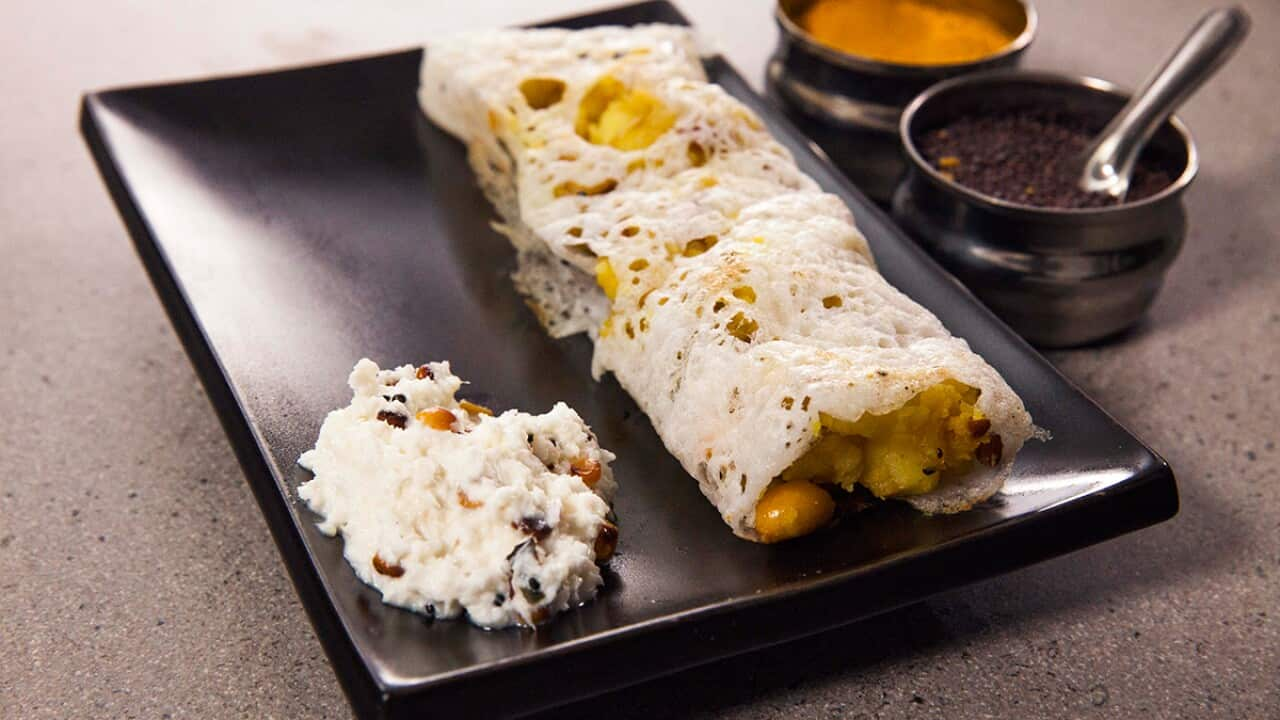makes
10
prep
1 hour
cook
1 hour
difficulty
Mid
makes
10
serves
preparation
1
hour
cooking
1
hour
difficulty
Mid
level
Ingredients
- 100 g (½ cup) basmati rice, soaked for 3 hours
- ⅔ tsp salt, or to taste
- 2 tbsp vegetable oil, plus 1 tbsp extra
- ½ small onion
Potato filling
- 500 g potatoes (around 2 medium), peeled and cut into 2 cm cubes
- 3-4 tbsp vegetable oil
- 1½ tsp brown mustard seeds
- 2-4 small dried red chillies (optional)
- 2 heaped tsp each channa dal (Bengal gram) and urad dal (skinned black gram)
- 12 fresh curry leaves
- 2 brown onions, thinly sliced
- salt, to taste
- ⅔ tsp ground turmeric
- ½ tsp ground coriander
- 1 tbsp lemon juice
- 50 g (⅓ cup) roasted salted peanuts
Coconut chutney
- 100 g freshly grated coconut (see Note)
- 100 g plain yoghurt
- 5 g piece peeled ginger, coarsely chopped
- 1 tbsp vegetable oil
- ¾ tsp brown mustard seeds
- 8-10 fresh curry leaves
- 1-2 small dried red chillies
- 1 rounded tbsp channa dal
- 1 tsp lemon juice, or to taste
Soaking time 3 hours
Instructions
To make the filling, cook the potatoes in a saucepan of lightly salted boiling water until just tender. Remove the potatoes with a slotted spoon, then reserve 1-2 tablespoons cooking water.
While the potatoes are cooking, heat the oil in a large non-stick frying pan over low-medium heat. Add the mustard seeds and cook until the popping starts to die down, then add the chillies and channa dal and after about 10 seconds follow with the other lentils. Cook until the lentils start to colour, then add the curry leaves, onions and season and cook for 10 minutes or until the onions are just caramelising on the edges. Add 1-2 tablespoons reserved potato cooking water, the turmeric and coriander and cook for 20 seconds. Add the potatoes and season to taste, then press down into the pan with a potato masher to coarsely mash the potatoes- there should be some large pieces as well as some mashed bits. Stir for 5 minutes or until well combined and lightly coloured. Add more water if it seems a bit dry. Remove from the heat, then stir in the lemon juice and peanuts and adjust the seasoning if necessary.
To make the coconut chutney, blend the coconut, yoghurt until quite smooth. Heat the oil in a small frying pan over medium heat. Add the mustard seeds and once they start to pop, reduce the heat to low, add the curry leaves, chillies and channa dal. Cook, stirring often until the channa dal turn a reddy-golden. Stir into the yoghurt with the lemon juice, then taste and adjust seasoning. Refrigerate until ready to use and for a few days after that.
To make the dosa, drain the rice, then place in a blender with 300 ml water and the salt. Blend for 4-5 minutes or until really thin, watery and smooth.
Heat a medium non-stick frying pan over medium heat. Place the oil in a small bowl. Spear the onion with a fork through the rounded side, then dip the flat side into the oil and wipe the surface of the pan with the oiled onion. When the pan is hot, pour in 60 ml (¼ cup) of the batter and tilt the pan to coat the base- it will be a bit lacy. Cook for 4-5 minutes until the underside is crisp and lightly brown and the upper side has lost its moist look. Gently ease your spatula underneath and loosen the dosa, flip it and cook it for another 30 seconds or until dry. Remove and repeat with the remaining batter, oiling the pan every time. If possible, have 2 pans cooking at the same time to speed up the process.
To assemble, place ¼ cup potato filling in the centre of each dosa and fold over one side, tuck in the sides and roll into a thick sausage. Wipe clean the pan you were cooking in, then place over low-medium heat and add 2 teaspoons extra oil. When hot, place half the rolls, seam-side up into the pan and cook gently until golden, then flip over and cook the seam side until golden. Repeat with the rest and serve with the coconut chutney.
Note
• It’s best to use freshly grated coconut for the chutney, but frozen grated coconut is a great substitute and is readily available from Indian food stores. Alternatively, you can use desiccated coconut- you may need to add a little water if the mixture is too thick.
starts Monday 4 April 2016 on Food Network Australia. Visit the for recipes and more.
Cook's Notes
Oven temperatures are for conventional; if using fan-forced (convection), reduce the temperature by 20˚C. | We use Australian tablespoons and cups: 1 teaspoon equals 5 ml; 1 tablespoon equals 20 ml; 1 cup equals 250 ml. | All herbs are fresh (unless specified) and cups are lightly packed. | All vegetables are medium size and peeled, unless specified. | All eggs are 55-60 g, unless specified.









